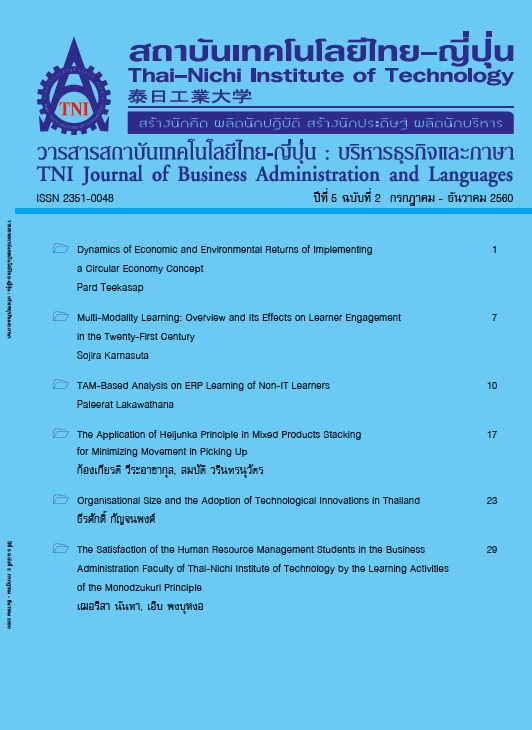The Application of Heijunka Principle in Mixed Products Stacking for Minimizing Movement in Picking up
Main Article Content
Abstract
The purpose of this experimental research aims to study the amount of moving goods in the warehouse of small retailers by comparing a result of two types of methods for stacking. Type1: Stacking goods sorted by product types but there are other types of goods placed on the heap. Type2: Stacking Goods by using Heijunka principle or stacking goods by mixing products with demand rate. For the area using: a space requirement of Type1 equal to 3,432 cm2 and a space requirement of Type2 equal to 3,481 cm2. The purposive sample was selected by using three stores of a small retailer of consumer products in Ampur Muang Chonburi Province. This experiment using 5 products in 5 units in the total of 25 units. That each product has a demand rate equal to one unit per day .For data collection type1 using 1 time and type2 using 3 times , due to the limited time. From the study, type1: the amount of moving goods equal to 41 times per product heap. And type2: the amount of moving goods equal to 30 times per product heap that type2 can reduce moving of goods equal to 26.82%
Article Details
Article Accepting Policy
The editorial board of Thai-Nichi Institute of Technology is pleased to receive articles from lecturers and experts in the fields of business administration, languages, engineering and technology written in Thai or English. The academic work submitted for publication must not be published in any other publication before and must not be under consideration of other journal submissions. Therefore, those interested in participating in the dissemination of work and knowledge can submit their article to the editorial board for further submission to the screening committee to consider publishing in the journal. The articles that can be published include solely research articles. Interested persons can prepare their articles by reviewing recommendations for article authors.
Copyright infringement is solely the responsibility of the author(s) of the article. Articles that have been published must be screened and reviewed for quality from qualified experts approved by the editorial board.
The text that appears within each article published in this research journal is a personal opinion of each author, nothing related to Thai-Nichi Institute of Technology, and other faculty members in the institution in any way. Responsibilities and accuracy for the content of each article are owned by each author. If there is any mistake, each author will be responsible for his/her own article(s).
The editorial board reserves the right not to bring any content, views or comments of articles in the Journal of Thai-Nichi Institute of Technology to publish before receiving permission from the authorized author(s) in writing. The published work is the copyright of the Journal of Thai-Nichi Institute of Technology.
References
สุจินดา เจียมพงษ์. “ธุรกิจค้าปลีกแบบดั้งเดิม (ร้านโชห่วย): ปัญหาและทางแก้ไข”, วารสารวิทยาการจัดการและสารสนเทศศาสตร์. ปีที่6, ฉบับที่ 1, หน้า 1-15. 2553.
คณาพร คํามูล. “การศึกษาการพัฒนาระบบการบริหารจัดการร้านค้าปลีกกรณีศึกษาร้านคุ้มบุญ ตําบลอาฮี จังหวัดเลย,” สารนิพนธ์ บธ.ม. (วิชาการประกอบการ), มหาวิทยาลัยหอการค้าไทย, กรุงเทพฯ, 2555.
“คูมือการบริหารจัดการร้านค้าปลีก,” กรมพัฒนาธุรกิจการค้า. [ออนไลน์]. แหล่งที่มา: https://www.dbd.go.th/download/project_retail/guidebook_ develop.pdf.[เข้าถึง: 07-Sep-2016].
“คู่มือการบริหารสินค้าสําหรับร้านค้าสหกรณ์,” กรมพัฒนาธุรกิจการค้า. [ออนไลน์]. แหล่งที่มา: https://www.dbd.go.th/download/project_retail/guidebook_develop.pdf.[เข้าถึง: 07-Sep-2016].
“เปิดร้านขายของชำ!! อาชีพอิสระคุณก็ทำได้,” KingSMEs, 2017. [ออนไลน์]. แหล่งที่มา: https://www.kingsmes.com/2015/03/my-business-ep-05.html. [เข้าถึง: 10-Oct-2016].
Shah, J. Supply Chain Management: Text and Cases, Pearson Education India. 2009.
“Packaging Logistics,” ธนิต โสรัตน์ [ออนไลน์]. แหล่งที่มา: https://www. logisticsdigest.com/component/content/article/29-october-2006/27-packaging-logistics.htm. [เข้าถึง: 07-Sep-2016].
“Different Types Of Packaging For Different Types Of Industry.” [Online]. Available: https://blog.bestpack.com/2012/09/different-types-of-packaging-for.html. [Accessed: 10-Oct-2016].
Bowersox, Donald J., Closs, David J., and Cooper M. Bixby, "Supply Chain Logistics Management", McGraw-Hill/Irwin, Burr Ridge. 2013.
McMahon, J. (2016, Oct 10). Maximizing Efficiency with Mixed-Case Palletizing [Online]. Available: https://www.scdigest.com/ experts/Holste _14-07-09.php?cid=8262
C. Holste, “Mixed SKU Pallet Loads Speeds Product Restocking At The Store : Technology Solves Complex Mixed Product Stacking Requirements.” [Online]. Available: https://www.scdigest.com/experts/ Holste_14-07-09.php?cid=8262. [Accessed: 10-Oct-2016].
R. F. Jamie, “Heijunka: The Art of Leveling Production.” [Online]. Available: https://www.isixsigma.com/methodology/lean-methodology/heijunka-the-art-of-leveling-production/. [Accessed: 10-Oct-2016].
M. Rosenthal, “The Importance of Heijunka,” The Lean Thinker, 03-Mar-2008. [Online]. Available: https://theleanthinker.com/2008/03/03/the- importance-of-heijunka/. [Accessed: 10-Dec-2016].
shmula, “Level Production Volume and Mix with Heijunka,” 16-Jul-2007. [Online]. Available: https://www.shmula.com/heijunka-leveling-by-volume-mix/410/. [Accessed: 10-Oct-2016].


